Motivation Theories: Impact on Employee Behavior in Organizations
VerifiedAdded on 2024/05/29
|16
|2981
|264
Essay
AI Summary
This essay explores the concept of motivation and its various theories within the context of organizational behavior. It discusses the importance of motivation in enhancing employee performance and satisfaction, referencing studies on the impact of motivation on organizational outcomes. The essay delves into specific motivation theories such as Maslow's hierarchy of needs and Herzberg's two-factor theory, examining their applications and criticisms. Furthermore, it distinguishes between intrinsic and extrinsic motivation, highlighting their respective roles in influencing employee behavior. The essay emphasizes the significance of effective management in leveraging motivational factors to achieve organizational goals, and the importance of both monetary and non-monetary incentives in motivating employees. This document is available on Desklib, a platform offering a wide range of study tools and resources for students.
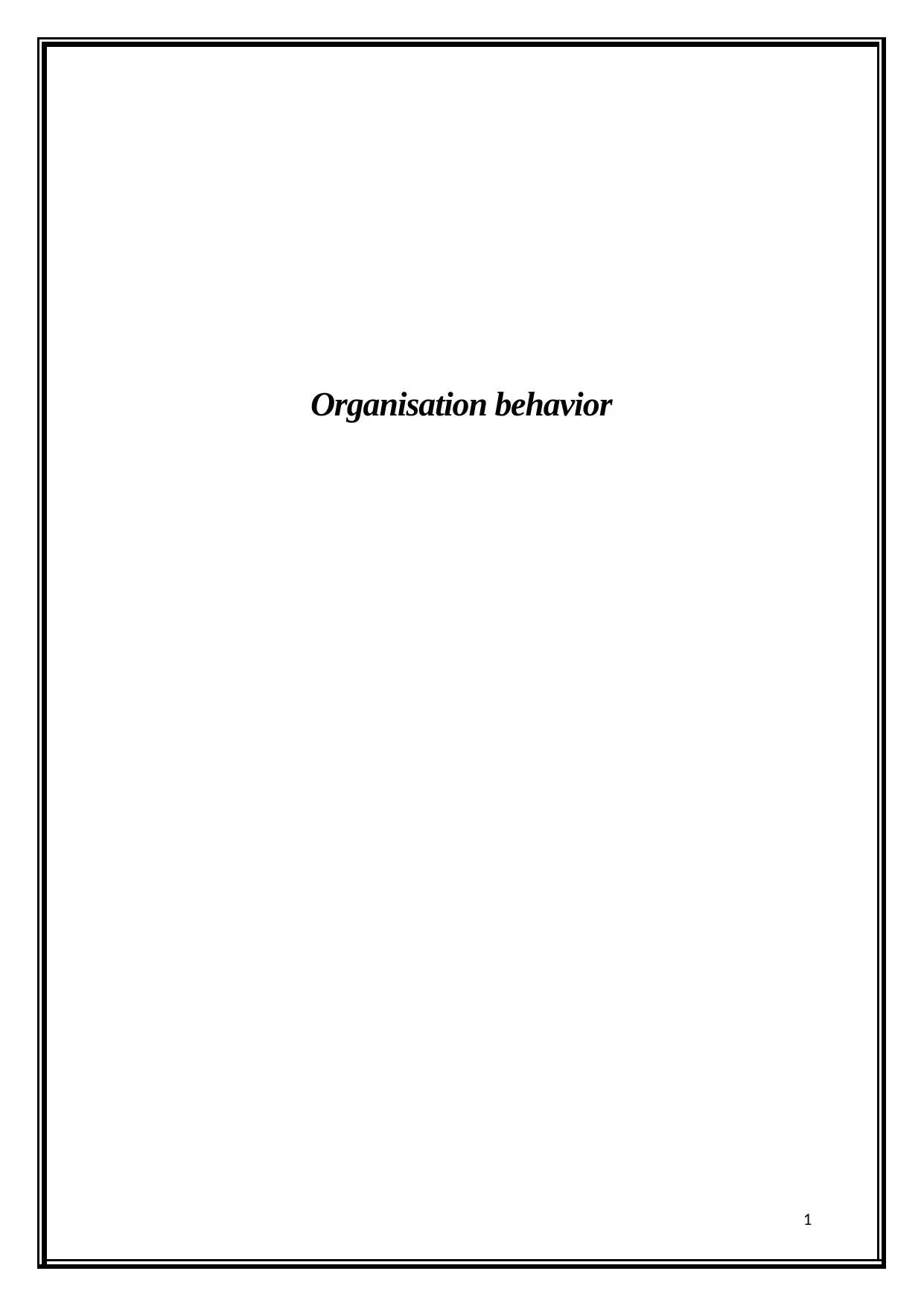
Organisation behavior
1
1
Paraphrase This Document
Need a fresh take? Get an instant paraphrase of this document with our AI Paraphraser
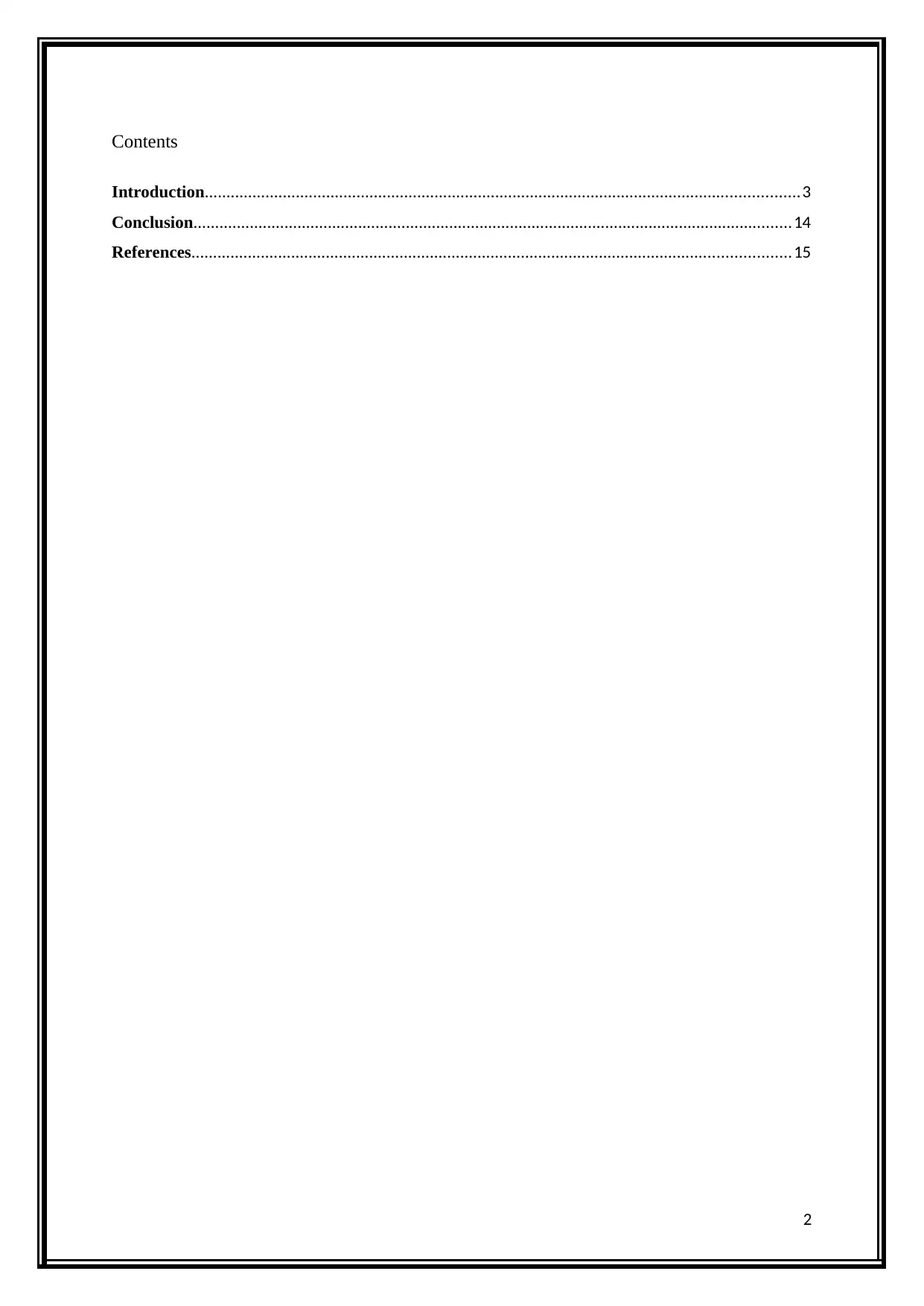
Contents
Introduction.........................................................................................................................................3
Conclusion..........................................................................................................................................14
References..........................................................................................................................................15
2
Introduction.........................................................................................................................................3
Conclusion..........................................................................................................................................14
References..........................................................................................................................................15
2
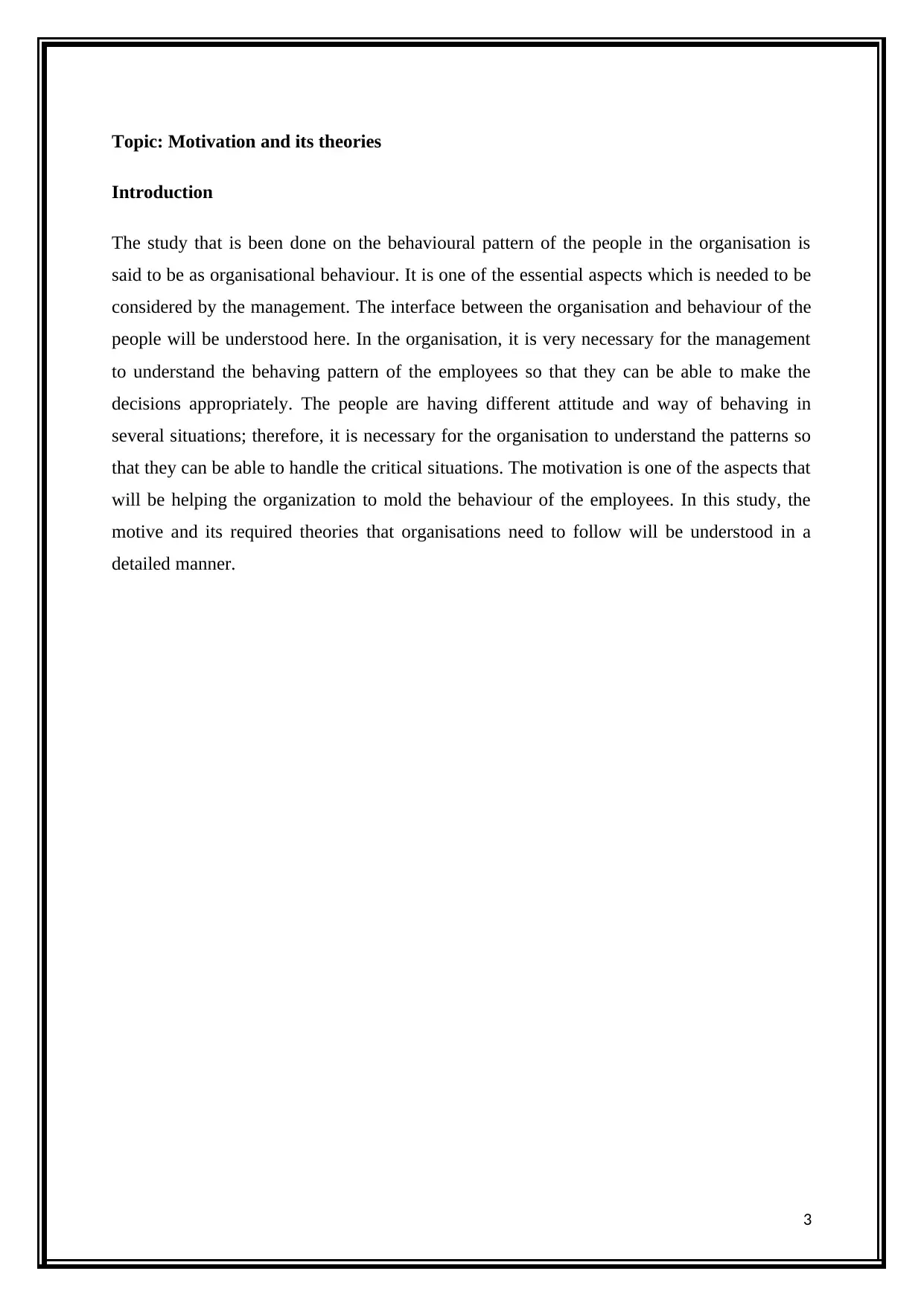
Topic: Motivation and its theories
Introduction
The study that is been done on the behavioural pattern of the people in the organisation is
said to be as organisational behaviour. It is one of the essential aspects which is needed to be
considered by the management. The interface between the organisation and behaviour of the
people will be understood here. In the organisation, it is very necessary for the management
to understand the behaving pattern of the employees so that they can be able to make the
decisions appropriately. The people are having different attitude and way of behaving in
several situations; therefore, it is necessary for the organisation to understand the patterns so
that they can be able to handle the critical situations. The motivation is one of the aspects that
will be helping the organization to mold the behaviour of the employees. In this study, the
motive and its required theories that organisations need to follow will be understood in a
detailed manner.
3
Introduction
The study that is been done on the behavioural pattern of the people in the organisation is
said to be as organisational behaviour. It is one of the essential aspects which is needed to be
considered by the management. The interface between the organisation and behaviour of the
people will be understood here. In the organisation, it is very necessary for the management
to understand the behaving pattern of the employees so that they can be able to make the
decisions appropriately. The people are having different attitude and way of behaving in
several situations; therefore, it is necessary for the organisation to understand the patterns so
that they can be able to handle the critical situations. The motivation is one of the aspects that
will be helping the organization to mold the behaviour of the employees. In this study, the
motive and its required theories that organisations need to follow will be understood in a
detailed manner.
3
⊘ This is a preview!⊘
Do you want full access?
Subscribe today to unlock all pages.

Trusted by 1+ million students worldwide
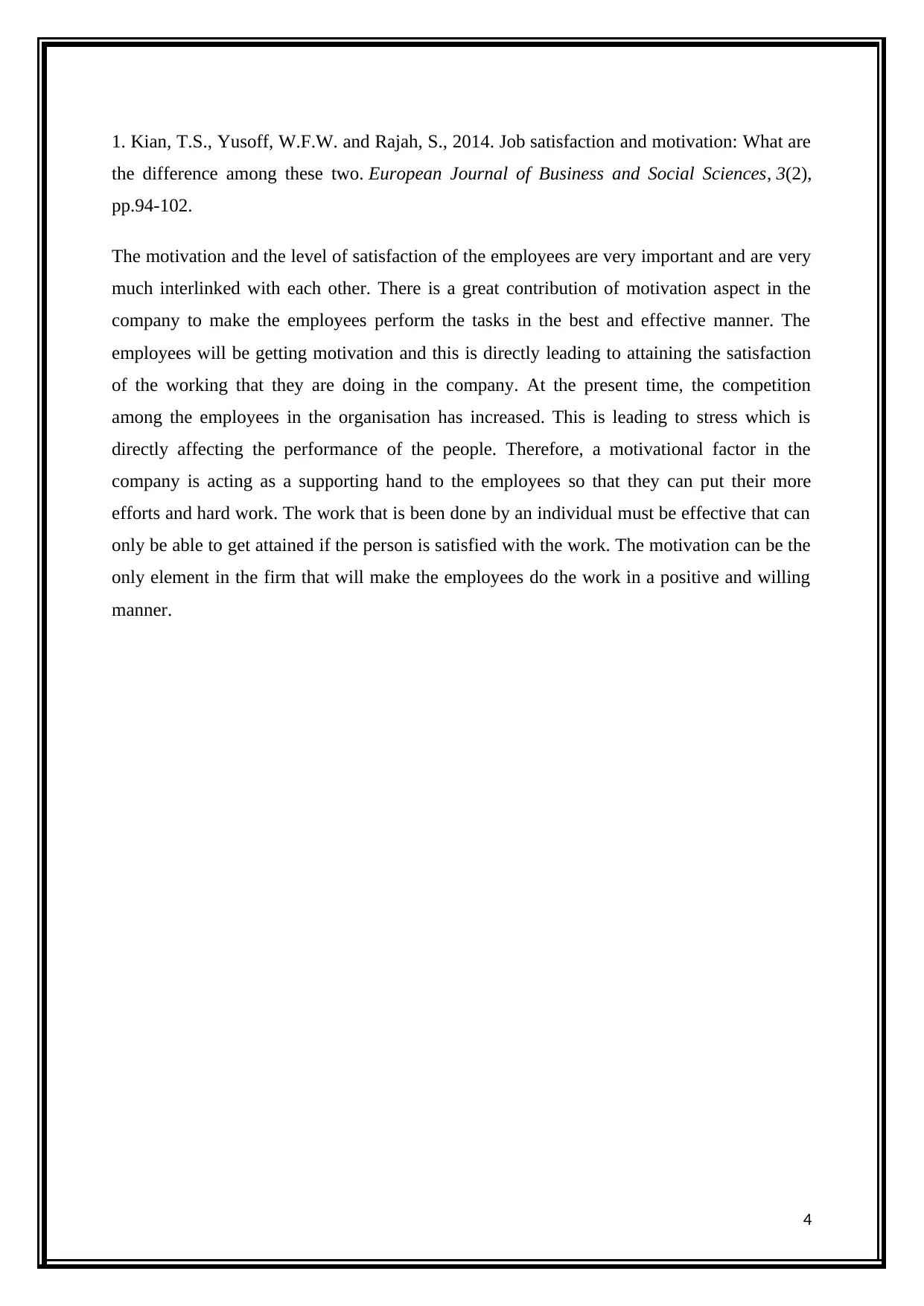
1. Kian, T.S., Yusoff, W.F.W. and Rajah, S., 2014. Job satisfaction and motivation: What are
the difference among these two. European Journal of Business and Social Sciences, 3(2),
pp.94-102.
The motivation and the level of satisfaction of the employees are very important and are very
much interlinked with each other. There is a great contribution of motivation aspect in the
company to make the employees perform the tasks in the best and effective manner. The
employees will be getting motivation and this is directly leading to attaining the satisfaction
of the working that they are doing in the company. At the present time, the competition
among the employees in the organisation has increased. This is leading to stress which is
directly affecting the performance of the people. Therefore, a motivational factor in the
company is acting as a supporting hand to the employees so that they can put their more
efforts and hard work. The work that is been done by an individual must be effective that can
only be able to get attained if the person is satisfied with the work. The motivation can be the
only element in the firm that will make the employees do the work in a positive and willing
manner.
4
the difference among these two. European Journal of Business and Social Sciences, 3(2),
pp.94-102.
The motivation and the level of satisfaction of the employees are very important and are very
much interlinked with each other. There is a great contribution of motivation aspect in the
company to make the employees perform the tasks in the best and effective manner. The
employees will be getting motivation and this is directly leading to attaining the satisfaction
of the working that they are doing in the company. At the present time, the competition
among the employees in the organisation has increased. This is leading to stress which is
directly affecting the performance of the people. Therefore, a motivational factor in the
company is acting as a supporting hand to the employees so that they can put their more
efforts and hard work. The work that is been done by an individual must be effective that can
only be able to get attained if the person is satisfied with the work. The motivation can be the
only element in the firm that will make the employees do the work in a positive and willing
manner.
4
Paraphrase This Document
Need a fresh take? Get an instant paraphrase of this document with our AI Paraphraser
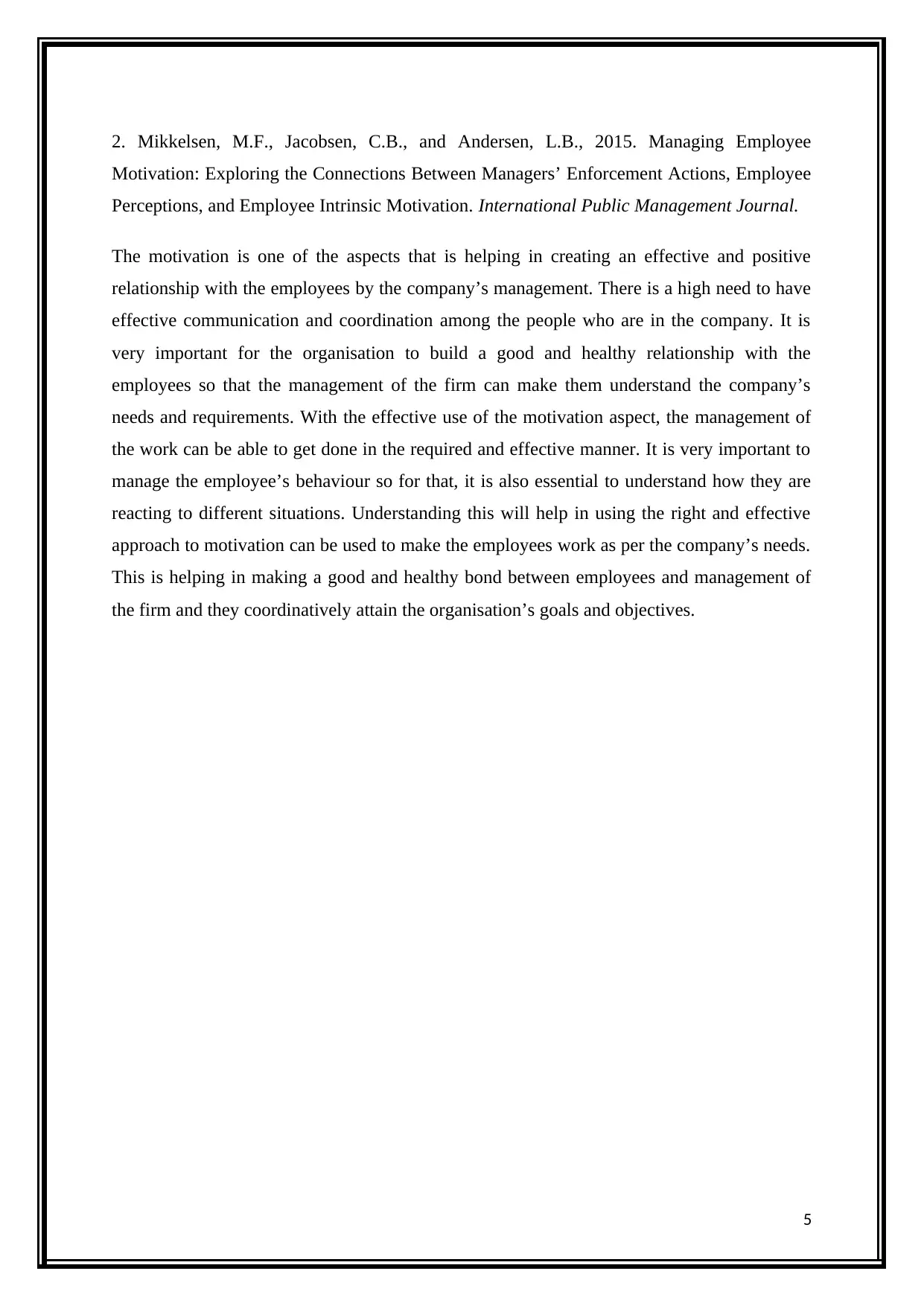
2. Mikkelsen, M.F., Jacobsen, C.B., and Andersen, L.B., 2015. Managing Employee
Motivation: Exploring the Connections Between Managers’ Enforcement Actions, Employee
Perceptions, and Employee Intrinsic Motivation. International Public Management Journal.
The motivation is one of the aspects that is helping in creating an effective and positive
relationship with the employees by the company’s management. There is a high need to have
effective communication and coordination among the people who are in the company. It is
very important for the organisation to build a good and healthy relationship with the
employees so that the management of the firm can make them understand the company’s
needs and requirements. With the effective use of the motivation aspect, the management of
the work can be able to get done in the required and effective manner. It is very important to
manage the employee’s behaviour so for that, it is also essential to understand how they are
reacting to different situations. Understanding this will help in using the right and effective
approach to motivation can be used to make the employees work as per the company’s needs.
This is helping in making a good and healthy bond between employees and management of
the firm and they coordinatively attain the organisation’s goals and objectives.
5
Motivation: Exploring the Connections Between Managers’ Enforcement Actions, Employee
Perceptions, and Employee Intrinsic Motivation. International Public Management Journal.
The motivation is one of the aspects that is helping in creating an effective and positive
relationship with the employees by the company’s management. There is a high need to have
effective communication and coordination among the people who are in the company. It is
very important for the organisation to build a good and healthy relationship with the
employees so that the management of the firm can make them understand the company’s
needs and requirements. With the effective use of the motivation aspect, the management of
the work can be able to get done in the required and effective manner. It is very important to
manage the employee’s behaviour so for that, it is also essential to understand how they are
reacting to different situations. Understanding this will help in using the right and effective
approach to motivation can be used to make the employees work as per the company’s needs.
This is helping in making a good and healthy bond between employees and management of
the firm and they coordinatively attain the organisation’s goals and objectives.
5
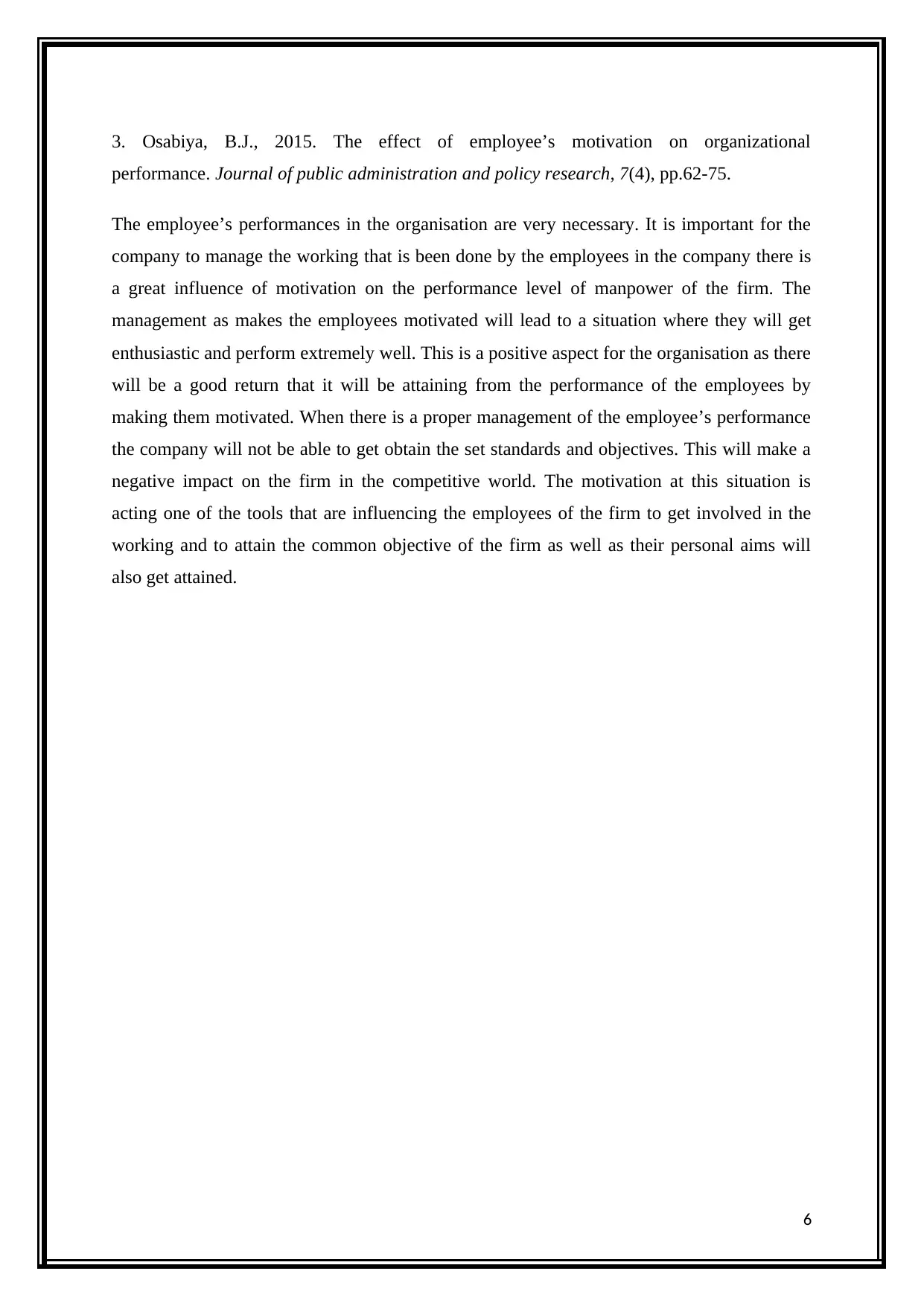
3. Osabiya, B.J., 2015. The effect of employee’s motivation on organizational
performance. Journal of public administration and policy research, 7(4), pp.62-75.
The employee’s performances in the organisation are very necessary. It is important for the
company to manage the working that is been done by the employees in the company there is
a great influence of motivation on the performance level of manpower of the firm. The
management as makes the employees motivated will lead to a situation where they will get
enthusiastic and perform extremely well. This is a positive aspect for the organisation as there
will be a good return that it will be attaining from the performance of the employees by
making them motivated. When there is a proper management of the employee’s performance
the company will not be able to get obtain the set standards and objectives. This will make a
negative impact on the firm in the competitive world. The motivation at this situation is
acting one of the tools that are influencing the employees of the firm to get involved in the
working and to attain the common objective of the firm as well as their personal aims will
also get attained.
6
performance. Journal of public administration and policy research, 7(4), pp.62-75.
The employee’s performances in the organisation are very necessary. It is important for the
company to manage the working that is been done by the employees in the company there is
a great influence of motivation on the performance level of manpower of the firm. The
management as makes the employees motivated will lead to a situation where they will get
enthusiastic and perform extremely well. This is a positive aspect for the organisation as there
will be a good return that it will be attaining from the performance of the employees by
making them motivated. When there is a proper management of the employee’s performance
the company will not be able to get obtain the set standards and objectives. This will make a
negative impact on the firm in the competitive world. The motivation at this situation is
acting one of the tools that are influencing the employees of the firm to get involved in the
working and to attain the common objective of the firm as well as their personal aims will
also get attained.
6
⊘ This is a preview!⊘
Do you want full access?
Subscribe today to unlock all pages.

Trusted by 1+ million students worldwide
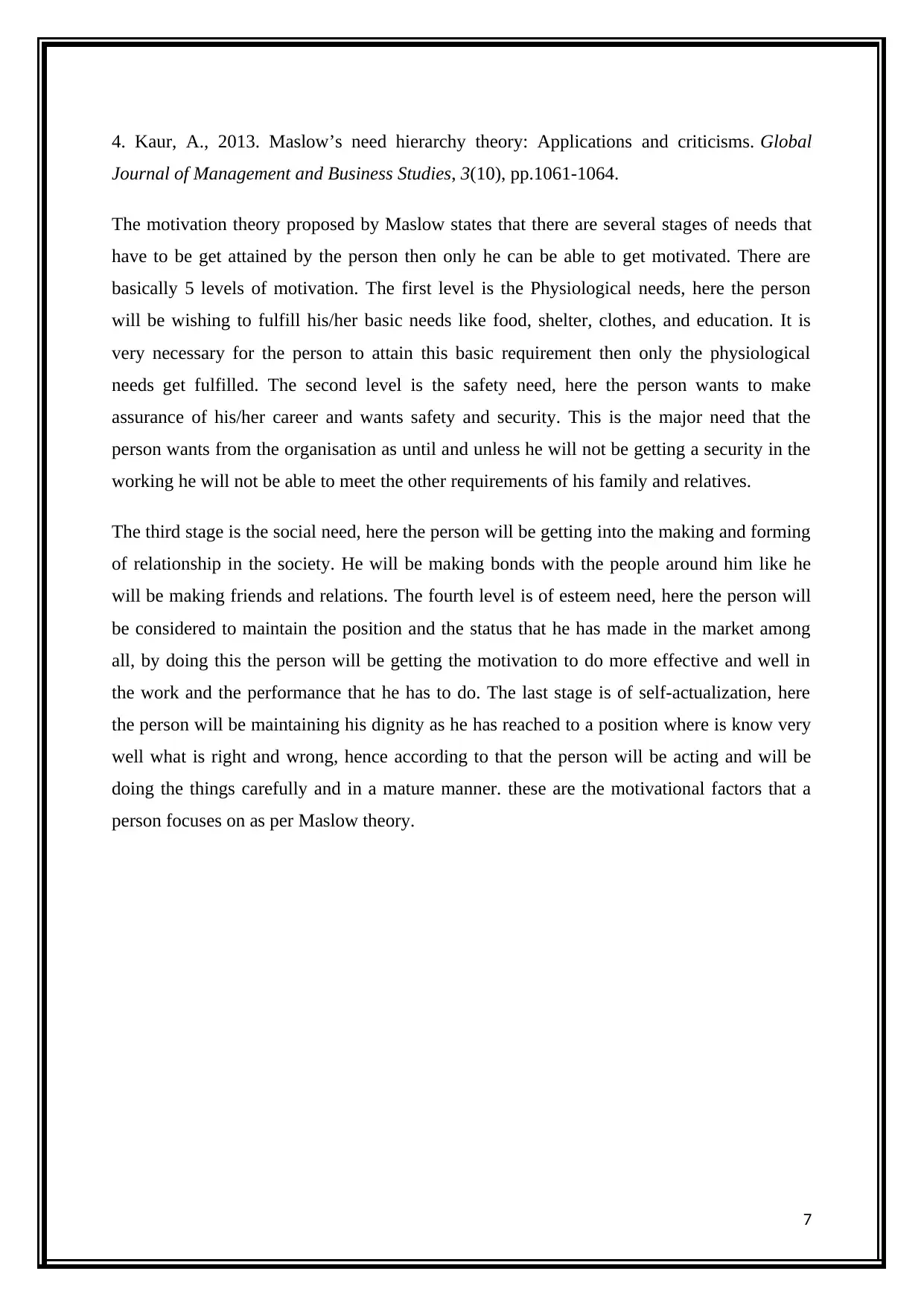
4. Kaur, A., 2013. Maslow’s need hierarchy theory: Applications and criticisms. Global
Journal of Management and Business Studies, 3(10), pp.1061-1064.
The motivation theory proposed by Maslow states that there are several stages of needs that
have to be get attained by the person then only he can be able to get motivated. There are
basically 5 levels of motivation. The first level is the Physiological needs, here the person
will be wishing to fulfill his/her basic needs like food, shelter, clothes, and education. It is
very necessary for the person to attain this basic requirement then only the physiological
needs get fulfilled. The second level is the safety need, here the person wants to make
assurance of his/her career and wants safety and security. This is the major need that the
person wants from the organisation as until and unless he will not be getting a security in the
working he will not be able to meet the other requirements of his family and relatives.
The third stage is the social need, here the person will be getting into the making and forming
of relationship in the society. He will be making bonds with the people around him like he
will be making friends and relations. The fourth level is of esteem need, here the person will
be considered to maintain the position and the status that he has made in the market among
all, by doing this the person will be getting the motivation to do more effective and well in
the work and the performance that he has to do. The last stage is of self-actualization, here
the person will be maintaining his dignity as he has reached to a position where is know very
well what is right and wrong, hence according to that the person will be acting and will be
doing the things carefully and in a mature manner. these are the motivational factors that a
person focuses on as per Maslow theory.
7
Journal of Management and Business Studies, 3(10), pp.1061-1064.
The motivation theory proposed by Maslow states that there are several stages of needs that
have to be get attained by the person then only he can be able to get motivated. There are
basically 5 levels of motivation. The first level is the Physiological needs, here the person
will be wishing to fulfill his/her basic needs like food, shelter, clothes, and education. It is
very necessary for the person to attain this basic requirement then only the physiological
needs get fulfilled. The second level is the safety need, here the person wants to make
assurance of his/her career and wants safety and security. This is the major need that the
person wants from the organisation as until and unless he will not be getting a security in the
working he will not be able to meet the other requirements of his family and relatives.
The third stage is the social need, here the person will be getting into the making and forming
of relationship in the society. He will be making bonds with the people around him like he
will be making friends and relations. The fourth level is of esteem need, here the person will
be considered to maintain the position and the status that he has made in the market among
all, by doing this the person will be getting the motivation to do more effective and well in
the work and the performance that he has to do. The last stage is of self-actualization, here
the person will be maintaining his dignity as he has reached to a position where is know very
well what is right and wrong, hence according to that the person will be acting and will be
doing the things carefully and in a mature manner. these are the motivational factors that a
person focuses on as per Maslow theory.
7
Paraphrase This Document
Need a fresh take? Get an instant paraphrase of this document with our AI Paraphraser
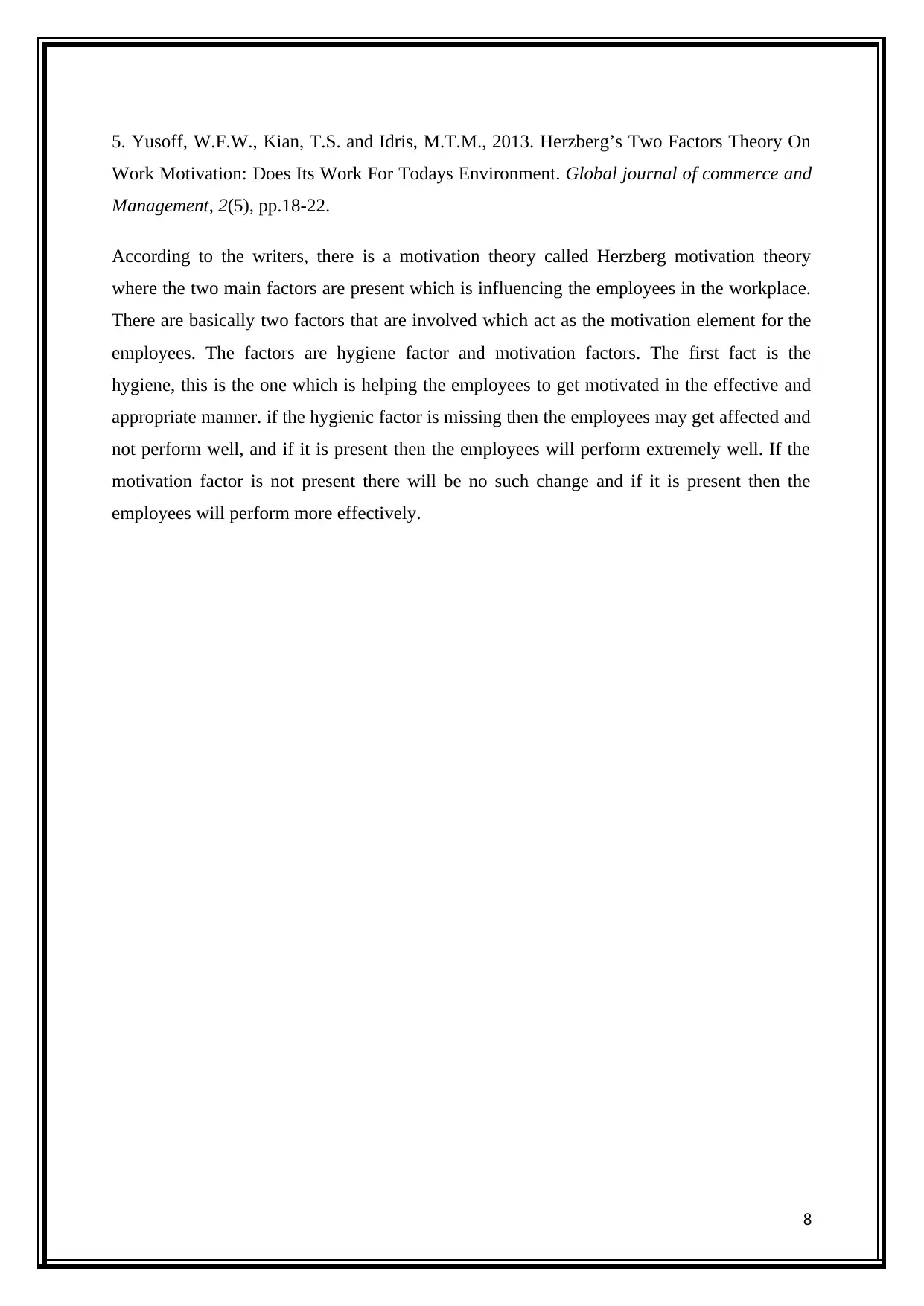
5. Yusoff, W.F.W., Kian, T.S. and Idris, M.T.M., 2013. Herzberg’s Two Factors Theory On
Work Motivation: Does Its Work For Todays Environment. Global journal of commerce and
Management, 2(5), pp.18-22.
According to the writers, there is a motivation theory called Herzberg motivation theory
where the two main factors are present which is influencing the employees in the workplace.
There are basically two factors that are involved which act as the motivation element for the
employees. The factors are hygiene factor and motivation factors. The first fact is the
hygiene, this is the one which is helping the employees to get motivated in the effective and
appropriate manner. if the hygienic factor is missing then the employees may get affected and
not perform well, and if it is present then the employees will perform extremely well. If the
motivation factor is not present there will be no such change and if it is present then the
employees will perform more effectively.
8
Work Motivation: Does Its Work For Todays Environment. Global journal of commerce and
Management, 2(5), pp.18-22.
According to the writers, there is a motivation theory called Herzberg motivation theory
where the two main factors are present which is influencing the employees in the workplace.
There are basically two factors that are involved which act as the motivation element for the
employees. The factors are hygiene factor and motivation factors. The first fact is the
hygiene, this is the one which is helping the employees to get motivated in the effective and
appropriate manner. if the hygienic factor is missing then the employees may get affected and
not perform well, and if it is present then the employees will perform extremely well. If the
motivation factor is not present there will be no such change and if it is present then the
employees will perform more effectively.
8
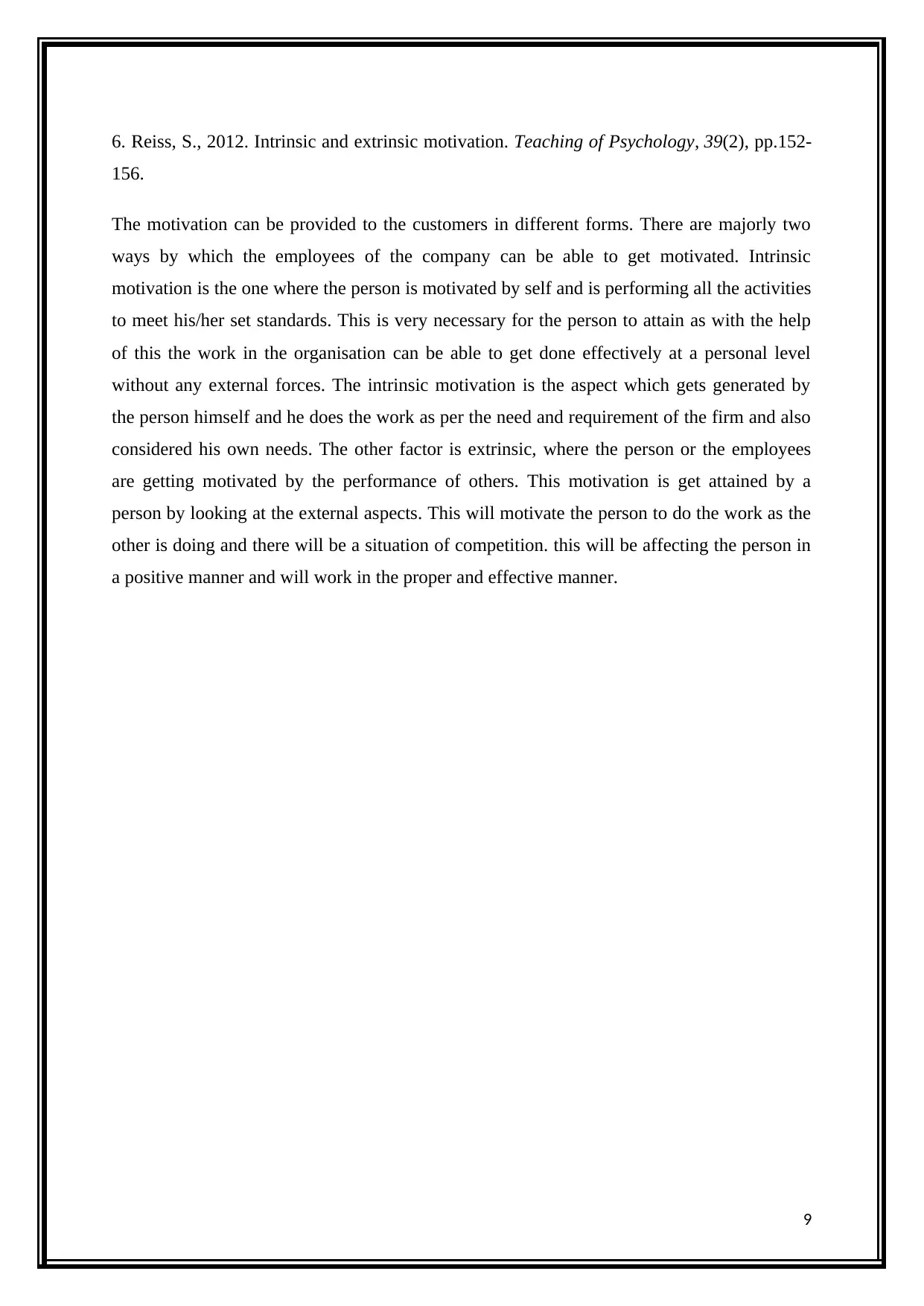
6. Reiss, S., 2012. Intrinsic and extrinsic motivation. Teaching of Psychology, 39(2), pp.152-
156.
The motivation can be provided to the customers in different forms. There are majorly two
ways by which the employees of the company can be able to get motivated. Intrinsic
motivation is the one where the person is motivated by self and is performing all the activities
to meet his/her set standards. This is very necessary for the person to attain as with the help
of this the work in the organisation can be able to get done effectively at a personal level
without any external forces. The intrinsic motivation is the aspect which gets generated by
the person himself and he does the work as per the need and requirement of the firm and also
considered his own needs. The other factor is extrinsic, where the person or the employees
are getting motivated by the performance of others. This motivation is get attained by a
person by looking at the external aspects. This will motivate the person to do the work as the
other is doing and there will be a situation of competition. this will be affecting the person in
a positive manner and will work in the proper and effective manner.
9
156.
The motivation can be provided to the customers in different forms. There are majorly two
ways by which the employees of the company can be able to get motivated. Intrinsic
motivation is the one where the person is motivated by self and is performing all the activities
to meet his/her set standards. This is very necessary for the person to attain as with the help
of this the work in the organisation can be able to get done effectively at a personal level
without any external forces. The intrinsic motivation is the aspect which gets generated by
the person himself and he does the work as per the need and requirement of the firm and also
considered his own needs. The other factor is extrinsic, where the person or the employees
are getting motivated by the performance of others. This motivation is get attained by a
person by looking at the external aspects. This will motivate the person to do the work as the
other is doing and there will be a situation of competition. this will be affecting the person in
a positive manner and will work in the proper and effective manner.
9
⊘ This is a preview!⊘
Do you want full access?
Subscribe today to unlock all pages.

Trusted by 1+ million students worldwide
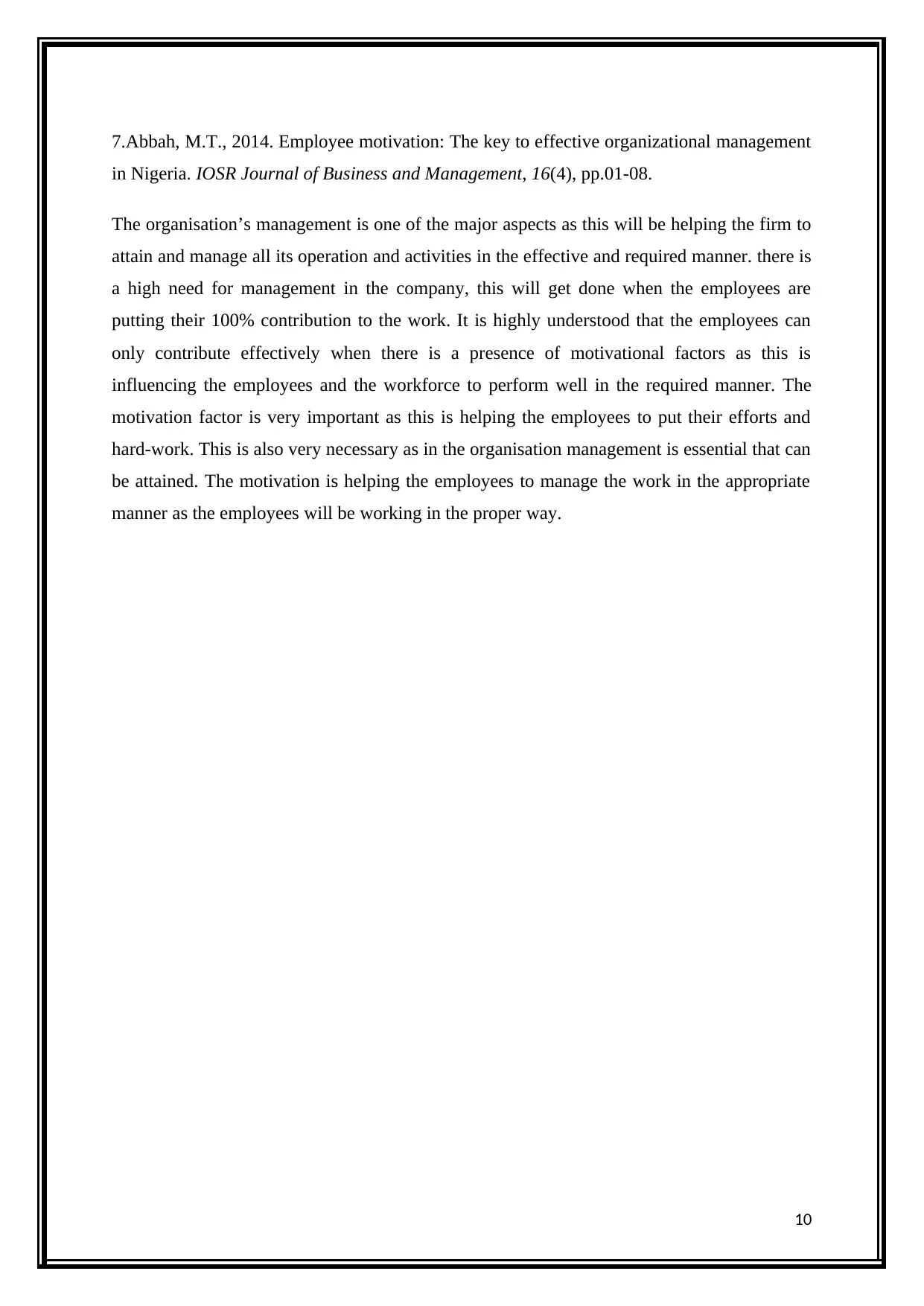
7.Abbah, M.T., 2014. Employee motivation: The key to effective organizational management
in Nigeria. IOSR Journal of Business and Management, 16(4), pp.01-08.
The organisation’s management is one of the major aspects as this will be helping the firm to
attain and manage all its operation and activities in the effective and required manner. there is
a high need for management in the company, this will get done when the employees are
putting their 100% contribution to the work. It is highly understood that the employees can
only contribute effectively when there is a presence of motivational factors as this is
influencing the employees and the workforce to perform well in the required manner. The
motivation factor is very important as this is helping the employees to put their efforts and
hard-work. This is also very necessary as in the organisation management is essential that can
be attained. The motivation is helping the employees to manage the work in the appropriate
manner as the employees will be working in the proper way.
10
in Nigeria. IOSR Journal of Business and Management, 16(4), pp.01-08.
The organisation’s management is one of the major aspects as this will be helping the firm to
attain and manage all its operation and activities in the effective and required manner. there is
a high need for management in the company, this will get done when the employees are
putting their 100% contribution to the work. It is highly understood that the employees can
only contribute effectively when there is a presence of motivational factors as this is
influencing the employees and the workforce to perform well in the required manner. The
motivation factor is very important as this is helping the employees to put their efforts and
hard-work. This is also very necessary as in the organisation management is essential that can
be attained. The motivation is helping the employees to manage the work in the appropriate
manner as the employees will be working in the proper way.
10
Paraphrase This Document
Need a fresh take? Get an instant paraphrase of this document with our AI Paraphraser
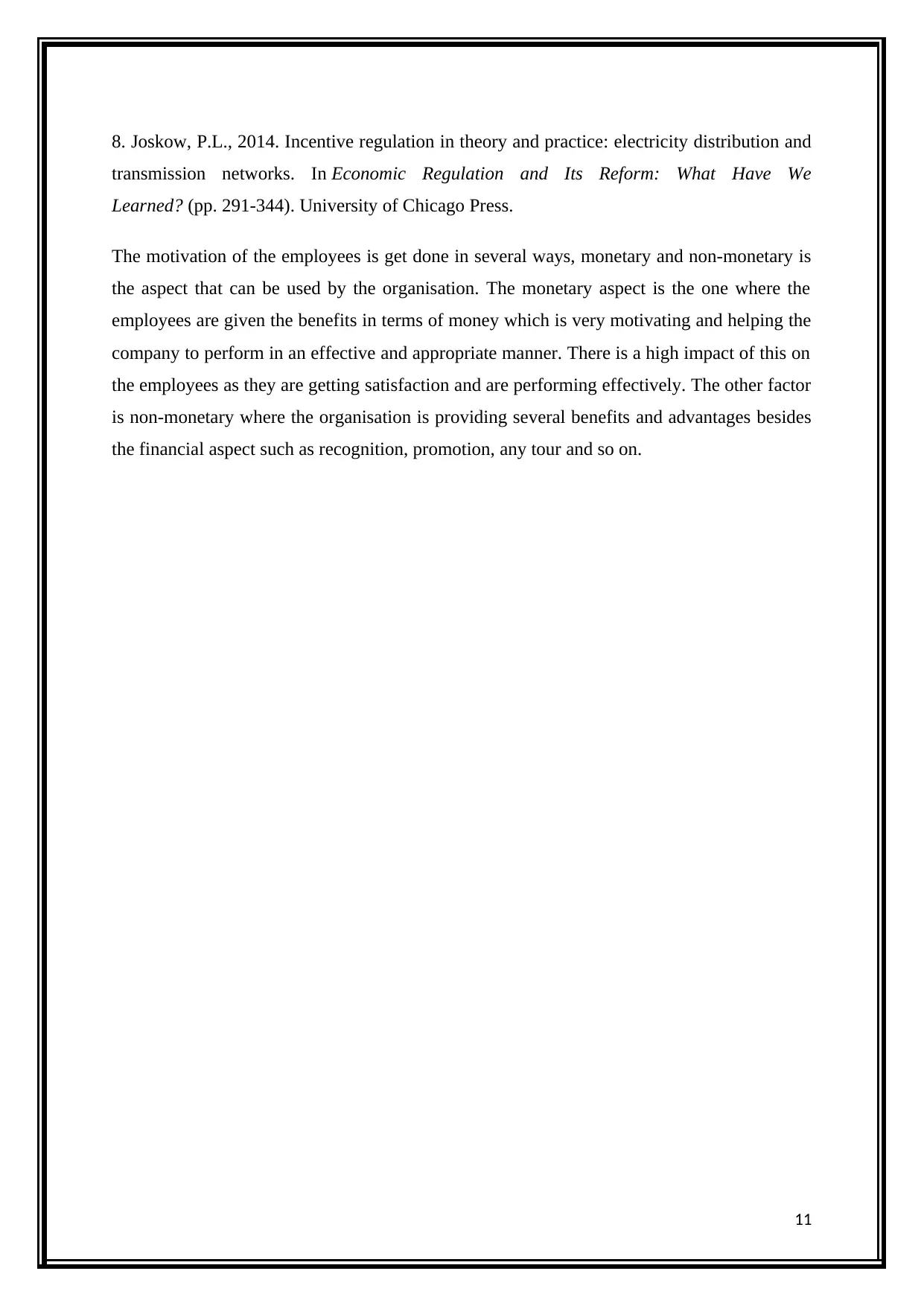
8. Joskow, P.L., 2014. Incentive regulation in theory and practice: electricity distribution and
transmission networks. In Economic Regulation and Its Reform: What Have We
Learned? (pp. 291-344). University of Chicago Press.
The motivation of the employees is get done in several ways, monetary and non-monetary is
the aspect that can be used by the organisation. The monetary aspect is the one where the
employees are given the benefits in terms of money which is very motivating and helping the
company to perform in an effective and appropriate manner. There is a high impact of this on
the employees as they are getting satisfaction and are performing effectively. The other factor
is non-monetary where the organisation is providing several benefits and advantages besides
the financial aspect such as recognition, promotion, any tour and so on.
11
transmission networks. In Economic Regulation and Its Reform: What Have We
Learned? (pp. 291-344). University of Chicago Press.
The motivation of the employees is get done in several ways, monetary and non-monetary is
the aspect that can be used by the organisation. The monetary aspect is the one where the
employees are given the benefits in terms of money which is very motivating and helping the
company to perform in an effective and appropriate manner. There is a high impact of this on
the employees as they are getting satisfaction and are performing effectively. The other factor
is non-monetary where the organisation is providing several benefits and advantages besides
the financial aspect such as recognition, promotion, any tour and so on.
11
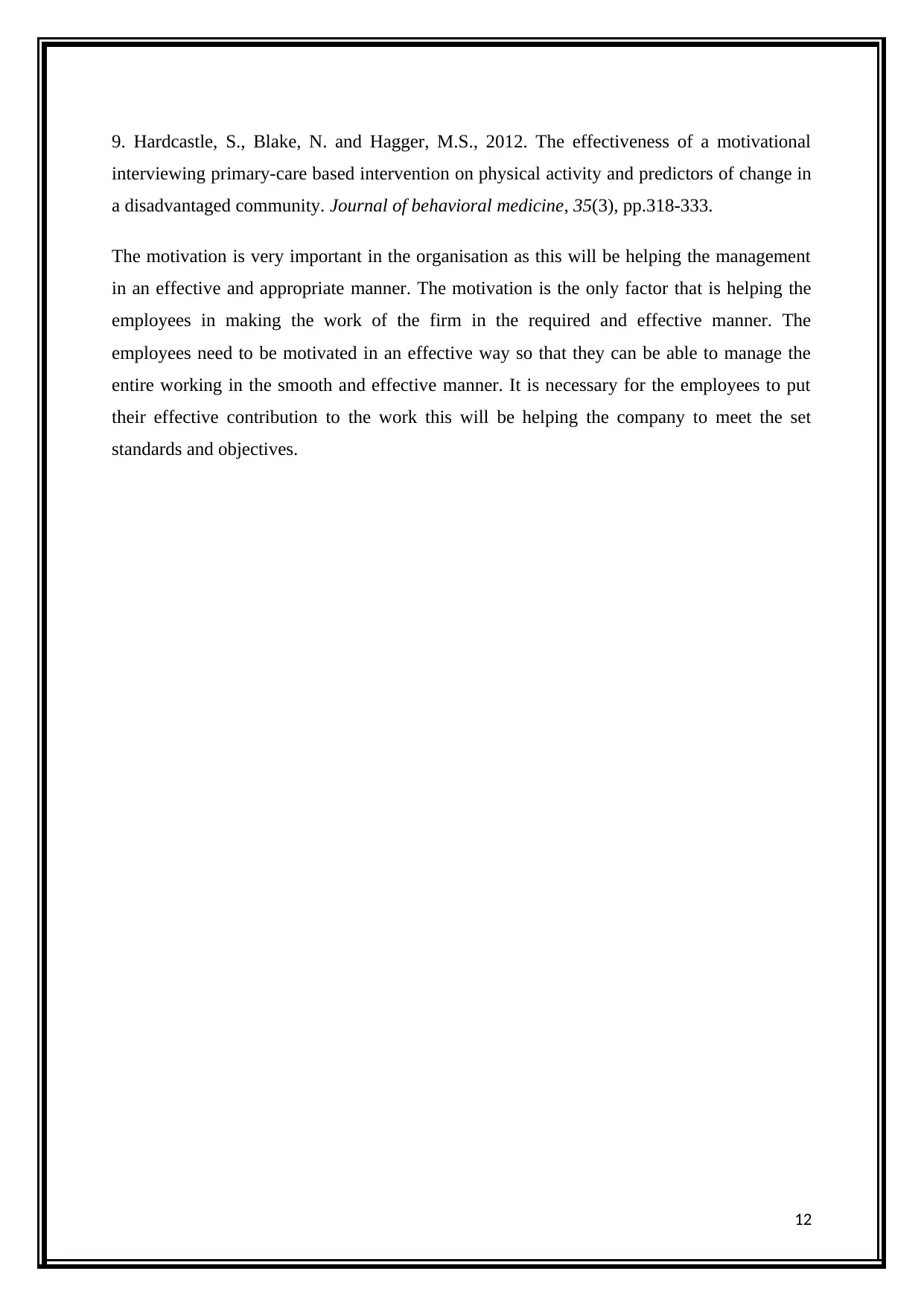
9. Hardcastle, S., Blake, N. and Hagger, M.S., 2012. The effectiveness of a motivational
interviewing primary-care based intervention on physical activity and predictors of change in
a disadvantaged community. Journal of behavioral medicine, 35(3), pp.318-333.
The motivation is very important in the organisation as this will be helping the management
in an effective and appropriate manner. The motivation is the only factor that is helping the
employees in making the work of the firm in the required and effective manner. The
employees need to be motivated in an effective way so that they can be able to manage the
entire working in the smooth and effective manner. It is necessary for the employees to put
their effective contribution to the work this will be helping the company to meet the set
standards and objectives.
12
interviewing primary-care based intervention on physical activity and predictors of change in
a disadvantaged community. Journal of behavioral medicine, 35(3), pp.318-333.
The motivation is very important in the organisation as this will be helping the management
in an effective and appropriate manner. The motivation is the only factor that is helping the
employees in making the work of the firm in the required and effective manner. The
employees need to be motivated in an effective way so that they can be able to manage the
entire working in the smooth and effective manner. It is necessary for the employees to put
their effective contribution to the work this will be helping the company to meet the set
standards and objectives.
12
⊘ This is a preview!⊘
Do you want full access?
Subscribe today to unlock all pages.

Trusted by 1+ million students worldwide
1 out of 16
Related Documents
Your All-in-One AI-Powered Toolkit for Academic Success.
+13062052269
info@desklib.com
Available 24*7 on WhatsApp / Email
![[object Object]](/_next/static/media/star-bottom.7253800d.svg)
Unlock your academic potential
Copyright © 2020–2025 A2Z Services. All Rights Reserved. Developed and managed by ZUCOL.





